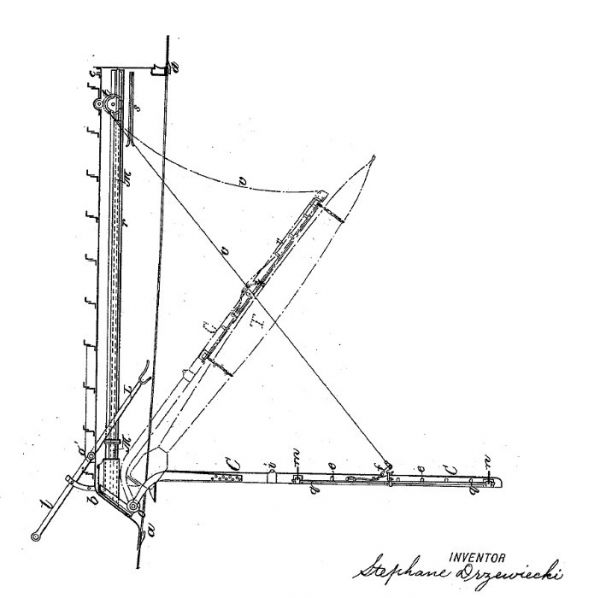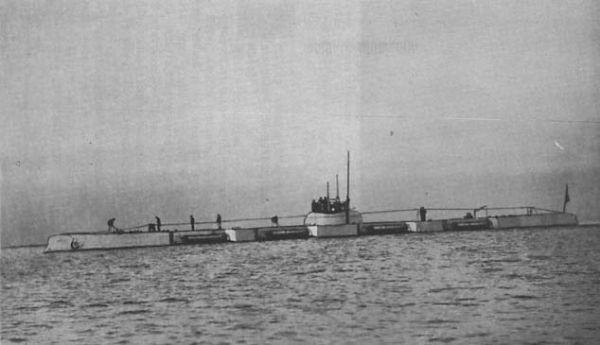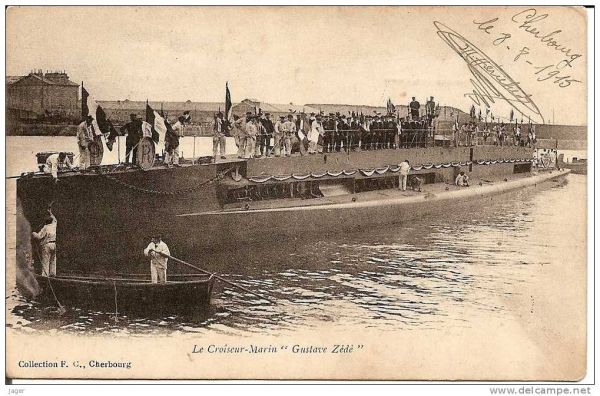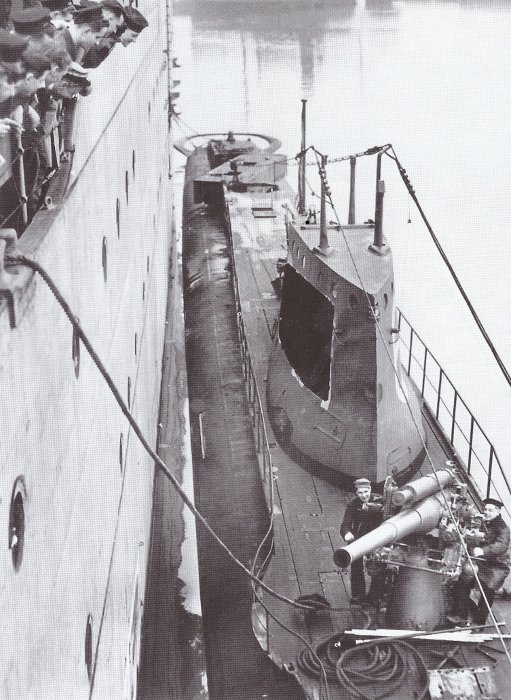Submarine external torpedo tubes
One of the trends in submarines development from the very start was to increase the number of available torpedo tubes. Initially early submarines, due to their small displacement – that is the small amount of space in the hull, were equipped with only one or two torpedo tubes (i.e. British submarines of the Holland class or A class, American submarines of the Plunger class, and German submarines of the U1 class). When larger submarines were constructed, it was possible to fit them with more than one bow torpedo tube and at least one stern torpedo tube. The problem of the number of torpedo tubes being constrained by limited space inside the hull was solved by installing external torpedo tubes outside the hull under the upper deck.
One of the types of external torpedo tubes was an installation invented and patented by Stefan Drzewiecki at the end of the 19th century known as a Drop-collar torpedo launcher.
The Drzewiecki torpedo launcher consisted of a horizontal splint installed along the side of the submarine. Two collars were attached to this splint which held the torpedo. One end of the splint was attached to the submarine hull by means of a hinge. The other end could be (by means of a pneumatic actuator) moved away from the submarine hull. Thus the splint (with torpedo) could be offset from the longitudinal axis of the submarine. When the angle between the splint and the longitudinal axis of the hull reaches a preset value, the torpedo engine automatically starts up. The Drzewiecki torpedo launcher solved the problem of aiming torpedoes during the period when torpedoes were not equipped with gyro-angled setting gear. Torpedoes could then be launched on any course from 0 to 90°, without having to maneuver the whole submarine as in the case of using fixed internal torpedo tubes. Moreover, compressed air was not used to launch a torpedo from a Drzewiecki launcher thus it could not escape to the surface and reveal the location of the submarine. The obvious disadvantage of this system was that the torpedoes were continuously exposed to sea water and water pressure at depth. Because the use of the Drzewiecki torpedo launcher was abandoned before the introduction of depth charges, they never had to deal with the effects of a shock wave from an exploding depth charge on an uncovered torpedo.
Drawing 1. Drzewiecki torpedo launcher (view from the top) [1]
Drzewiecki torpedo launchers were popular in Russia (where most of the submarines in the Imperial Russian Navy were equipped with them including submarines of the class Bars, Narval, Morzh, Kaiman, and Delfin) and in France (the submarine Gustave Zédé and submarines of the Brumaire class).
Photo 1. Submarine of the Morzh class with visible Drzewiecki torpedo launchers under the upper deck [2]
Photo 2. Submarine of the Narval class with visible Drzewiecki torpedo launchers under the upper deck [2]
Photo 3. Submarine of the Bars class with visible Drzewiecki torpedo launchers under the upper deck [2]
Photo 4. Submarine Gustave Zédé with visible Drzewiecki torpedo launchers under the upper deck
Photo 5. Stern part of the model of French submarine Gustave Zédé
with visible Drzewiecki torpedo launcher [3]
Photo 6. U-Boat SM U-14 (ex Curie – French submarine of the Brumaire class) with visible
Drzewiecki torpedo launchers under the upper deck [4]
Photo 7. U-Boat SM U-14 (ex Curie – French submarine of the Brumaire class) with visible
Drzewiecki torpedo launchers under the upper deck [5]
Photo 8. The conning tower of French submarine Curie
(Brumaire class) with visible Drzewiecki torpedo launchers [6]
Fixed torpedo tubes were another type of external torpedo tube. They were constructed in a similar way as internal tubes. They consisted of a tube of a diameter appropriate for the torpedo caliber, muzzle and breech doors and auxiliary equipment – flood and drain installation and a torpedo firing installation. Among others, the following boats were equipped with external fixed torpedo tubes:
- American submarines USS Narwhal (SS-167) and USS Nautilus (SS-168)
- British submarines of the T class and the first three submarines of the U class
- German type VIIA U-Boats
Photo 9. USS Nautilus with visible muzzle doors of stern external torpedo tubes [7]
Photo 10. USS Nautilus with visible muzzle doors of bow external torpedo tubes [7]
Photo 11. Type VIIA U-Boats with visible stern external torpedo tubes
The most common type of external tubes were trainable external torpedo tubes. They were constructed like the fixed ones, but they were mounted (most often in sets of two) on trainable mountings. When unused, they were aligned with the longitudinal line of the hull, but when preparing to the launch, they were trained into the appropriate position. Trainable external torpedo tubes consisted of a tube of a diameter appropriate for the torpedo caliber, muzzle and breech doors and auxiliary equipment – flood and drain installation and a torpedo firing installation. The heart of the mounting was the gear which trained the tubes and locked them in the proper position and the system showing current position of the tubes. Trainable torpedo tubes were not fitted with the gyro-angle setting gear, but this was compensated for by the ability to train the tube to the correct position. Trainable torpedo tubes were adapted for submerged and surfaced launch. They were installed (among others) on the following submarines:
- American submarines of the AA class and submarine G-1 (USS Seal)
- Dutch submarines O19, O20, O24, KVII and KXV
- Polish submarines Orzeł class and Wilk class
- French submarines of the Saphir and Redoutable class and the submarine Surcouf
Photo 12. Submarine G-1 (later USS Seal) with visible external
trainable torpedo tubes under the upper deck [8]
Photo 13. Submarine ORP Wilk with visible external trainable
stern torpedo tube under the upper deck [9]
Submarines equipped with external torpedo tubes were in service during World War II but experience gathered during their service led to their being discontinued due to their disadvantages:
- torpedoes loaded in external torpedo tubes cannot be serviced while at sea
- exposure to sea water, pressure at depth and the explosions of depth charges
- the quite complex torpedo tube auxiliary equipment often failed which caused the whole torpedo tube to be out of service (i.e. unsuccessful attack of ORP Orzeł on 11 April 1940, when the training gear was jammed, or the faulty gears used for opening muzzle doors on the British submarines T class)
After World War II the displacement of newly built submarines increased so it was possible to increase the number of bow torpedo tubes. They also used hydraulic equipment for fast torpedo tube reloading, which also increased the number of torpedo salvos. So finally, external torpedo tubes were entirely abandoned.
References:
[1] Patent US 542876 A - S. Drzewiecki, Apparatus for ejecting or launching torpedoes
[2] I. D. Spassky, V. P. Semyonov, Norman Polmar, Submarines of the Tsarist Navy
[3] Sub-aliens - toy & RC model submarines
[4] SM U-14 (Austria-Hungary)
[5] Die k.u.k. U-Boote S.M.U. 12 - 17
[6] CURIE - Sous Marin
[7] Nautilus (SS-168)
[8] Seal / G-1 (SS-19½)
[9] Mariusz Borowiak, Stalowe drapieżniki















